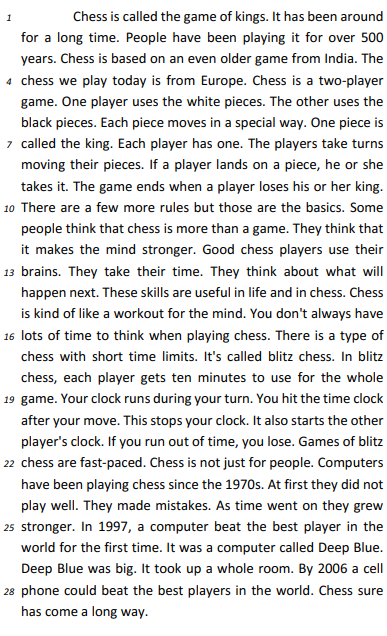Questões de Inglês - Substantivos contáveis e incontáveis | Countable and uncountable para Concurso
Foram encontradas 63 questões
According to the third paragraph, there are lots of lessons in music in Finnish schools.
Choose the only sentence in which the noun MUSIC was used correctly.
Education
Education encompasses both the teaching and learning of knowledge, proper conduct, and technical competency. It thus focuses on the cultivation of skills, trades or professions, as well as mental, moral & aesthetic development.
Formal education consists of systematic instruction, teaching and training by professional teachers. This consists of the application of pedagogy and the development of curricula.
The right to education is a fundamental human right. Since 1952, Article 2 of the first Protocol to the European Convention on Human Rights obliges all signatory parties to guarantee the right to education. At world level, the United Nations’ International Covenant on Economic, Social and Cultural Rights of 1966 guarantees this right under its Article 13.
Educational systems are established to provide education and training, often for children and the young. A curriculum defines what students should know, understand and be able to do as the result of education. A teaching profession delivers teaching which enables learning, and a system of policies, regulations, examinations, structures and funding enables teachers to teach to the best of their abilities.
Primary (or elementary) education consists of the first
years of formal, structured education. In general, primary education consists of six or seven years of schooling starting at the age of 5 or 6, although this varies
between, and sometimes within, countries. Globally,
around 70% of primary-age children are enrolled in
primary education, and this proportion is rising.
In most contemporary educational systems of the world, secondary education consists of the second years of formal education that occur during adolescence. It is characterized by transition from the typically compulsory, comprehensive primary education for minors, to the optional, selective tertiary, “post-secondary”, or “higher” education (e.g., university, vocational school) for adults.
Higher education, also called tertiary, third stage, or
post secondary education, is the non-compulsory
educational level that follows the completion of a
school providing a secondary education, such as a
high school or secondary school. Tertiary education is
normally taken to include undergraduate and postgraduate education, as well as vocational education and
training. Colleges and universities are the main institutions that provide tertiary education. Collectively,
these are sometimes known as tertiary institutions.
Tertiary education generally results in the receipt of
certificates, diplomas, or academic degrees.

Internet: <www.nortechplus.com>.
Read the following text and answer question.
Importance of Aquaculture
Aquaculture involves the art, science and business of breeding aquatic animals and plants in fresh or
marine waters for human use. It also extends to the marketing of such organisms in a controlled environment. It is a kind of agriculture, and therefore, it requires inputs such as clean water and nutrients.
It also requires storage for harvested produce, transportation and marketing facilities.
Inputs often depend on the species that are farmed. Species lower on the aquatic food chain usually require less input, as they feed on microorganisms and are fine in just clean water. More inputs like fish or fishmeal, cereals, or grains are required, as we get higher on the food chain with species like salmon or tuna.
All over the world, the demand for seafood has increased because people have learned that seafood as part of regular diets are healthier and help fight cardiovascular disease, cancer, Alzheimer’s and many other major illnesses.
Aquaculture will add to wild seafood, and make it _______ and accessible to all.
Aquaculture business provides tax and royalty revenue to local governments. Besides, there is also potential revenue from exports.
(Adapted from: https://goo.gl/qcbcfY. Access: 01/25/2018)